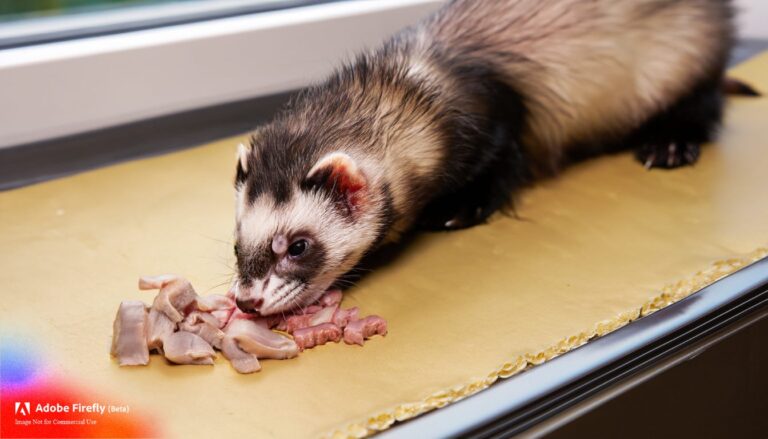
Are you a proud bird owner who’s considering getting a ferret as a new addition to your furry family? Well, you’re in luck! In this article, I’ll show you how to transform your bird cage into a cozy and secure home for your ferret. With a few simple modifications, you can repurpose your existing bird cage and provide a comfortable living space for your curious and playful ferret. So, let’s get started and give your feathered friend’s old home a ferret-friendly makeover!
Gather the Necessary Supplies
When it comes to repurposing a bird cage into a ferret cage, having the right supplies is crucial. Here are the essential items you’ll need to create a cozy and secure home for your ferret:
- Bird Cage: Start with a bird cage that is spacious enough to accommodate your ferret comfortably. Look for a cage with bars that are close enough together to prevent your ferret from squeezing through.
- Cage Liner: Ferrets can be messy, so having a suitable cage liner is important. Opt for a washable liner made of fleece or other non-toxic materials. This allows for easy cleaning and provides a cozy surface for your ferret to rest on.
- Hideouts: Ferrets love to have a place to hide and feel secure. Provide them with multiple hideouts, such as tunnels and hammocks, where they can retreat and relax.
- Toys: Keeping your ferret entertained is essential for their well-being. Provide them with a variety of toys, such as interactive toys, balls, and chew toys, to keep them mentally stimulated and physically active.
- Food and Water Dishes: Make sure you have separate dishes for food and water. Choose dishes that are easy to clean and will securely attach to the cage.
- Bedding: Ferrets love to burrow and nest, so provide them with soft bedding material, such as blankets or towels, to make their cage feel cozy and comfortable.
- Litter Box: Ferrets can be trained to use a litter box, just like cats. Place a litter box in one corner of the cage and fill it with pelleted litter. This will help keep the cage clean and odor-free.
- Cage Accessories: Consider adding platforms, ramps, and shelves to the cage to create additional levels and climbing opportunities for your ferret. This will not only make the cage more interesting but also provide exercise for your furry friend.
By gathering these necessary supplies, you’ll be well on your way to transforming your bird cage into a ferret-friendly haven. Remember, the key is to provide a comfortable and stimulating environment for your ferret’s well-being. Now that you have the supplies, it’s time to move on to the next step – modifying the cage for your ferret’s needs.
Assess the Bird Cage
Before you repurpose your bird cage into a ferret cage, it’s important to assess the cage to ensure it meets the necessary requirements for your furry friend. Here are a few things to consider when evaluating the bird cage:
- Size: Ferrets are active and playful animals, so they require ample space to move around and explore. Make sure the bird cage is spacious enough to accommodate your ferret comfortably. The cage should have enough room for them to stretch, play, and climb without feeling cramped.
- Bar Spacing: Ferrets are notorious escape artists, so it’s crucial to check the bar spacing on the bird cage. The gaps between the bars should be small enough to prevent your ferret from squeezing through or getting stuck. Ideally, the spacing should be no more than 1 inch to ensure their safety.
- Material: Consider the material of the bird cage. Ferrets are known for their chewing habits, so it’s important to choose a cage made of sturdy and durable material. Avoid cages with plastic components that can be easily chewed through, as these can pose a choking hazard to your furry friend.
- Accessibility: Look for a bird cage that allows easy access for cleaning and maintenance. A cage with multiple doors or removable trays will make it easier for you to keep the environment clean and hygienic for your ferret.
Assessing the bird cage is the first step in repurposing it into a suitable home for your ferret. By ensuring the cage is of the right size, has appropriate bar spacing, is made of durable material, and allows for easy access, you can create a comfortable and secure living space for your ferret.
Remove Any Perches or Ladders
When repurposing a bird cage into a ferret cage, the first step is to Remove Any Perches or Ladders that may be present. This is essential because perches and ladders are designed for birds, not ferrets, and can pose a safety hazard to your furry friend. Ferrets are curious and agile creatures, and they may try to climb or jump onto these structures, leading to potential injuries.
To remove the perches or ladders, simply unscrew or unclip them from the cage. Make sure to carefully inspect the cage and remove any small pieces or sharp edges that could potentially harm your ferret. It’s important to create a safe environment for your furry companion.
By removing these structures, you are creating a more spacious and secure living area for your ferret. Ferrets are natural burrowers and climbers, so they will appreciate the extra room to explore and play. Removing the perches and ladders also allows you to rearrange the cage to better suit your ferret’s needs and provide more vertical space for them to navigate.
Install a Solid Floor
When repurposing a bird cage into a ferret cage, it’s important to install a solid floor. Unlike birds, ferrets need a stable surface to walk on and a solid floor helps prevent injury to their paws. Here are a few steps to help you install a solid floor in your bird cage:
- Measure the dimensions of the cage: Before installing a solid floor, measure the length and width of the cage interior. This will ensure that you purchase the correct size of material for the floor.
- Choose a suitable flooring material: There are several options to consider when selecting a flooring material for your ferret cage. Some common choices include:
- Marine-grade plywood: This is a durable and water-resistant option that can withstand the temperature and humidity levels in the cage.
- Vinyl flooring: Vinyl is another popular choice as it’s easy to clean and provides a smooth surface for your ferret to walk on.
- Ceramic tiles: Ceramic tiles are sturdy, hygienic, and can withstand the wear and tear of ferret activity.
- Secure the flooring to the cage: Once you have chosen the flooring material, cut it to fit the dimensions of the cage. Use appropriate screws or adhesive to secure the floor to the bottom of the cage. Ensure that the edges are smooth and there are no sharp edges or gaps where your ferret could get stuck or injured.
- Add a waterproof liner: To protect the flooring from spills and accidents, consider adding a waterproof liner between the solid floor and the cage bottom. This will make it easier to clean up any messes and maintain a hygienic environment for your ferret.
By installing a solid floor in your bird cage, you are creating a safe and comfortable space for your ferret to explore and play. It provides stability and prevents injuries, ensuring your furry friend’s well-being. Remember to choose a suitable flooring material and secure it properly to the cage. With a solid floor in place, your ferret will enjoy their new home and you can have peace of mind knowing they are safe.
Add Appropriate Bedding and Litter Box
When repurposing a bird cage into a ferret cage, it is important to provide the appropriate bedding and a litter box for your furry friend. Ferrets have unique needs when it comes to their living environment, and ensuring they have proper bedding and a designated area for their waste is crucial for their well-being.
Bedding: Choosing the right bedding material is essential for keeping your ferret comfortable and cozy. Avoid using materials that could be harmful if ingested, such as cedar or pine shavings. Instead, opt for ferret-safe bedding options like recycled paper bedding, fleece liners, or towels. These materials are soft, absorbent, and easy to clean.
When adding bedding to the ferret cage, make sure to line the bottom of the cage with a layer of bedding that is at least a few inches thick. This will provide a soft and comfortable surface for your ferret to rest and play on. Keep in mind that ferrets love to burrow, so providing them with extra bedding to snuggle into will make them feel secure and content.
Litter Box: Ferrets are naturally inclined to use a litter box, so it is important to have a designated area for them to do their business. Choose a litter box that is large enough for them to comfortably enter and move around in. A rectangular shape works best as it allows the ferret to align themselves properly.
Place the litter box in a corner of the cage to help establish a routine for your ferret and make it easier for them to find and use. Fill the litter box with a ferret-safe litter, such as pelleted newspaper litter or recycled paper litter. Avoid clay or clumping litters, as these can be harmful if ingested.
Be sure to clean the litter box regularly to maintain a hygienic and odor-free environment for your ferret. Scoop out any waste daily and replace the litter as needed. This will help keep your ferret’s cage clean and prevent any potential health issues.
By providing appropriate bedding and a litter box, you are ensuring that your ferret has a comfortable and clean living space. These simple additions will greatly contribute to your ferret’s overall well-being and happiness.
Provide Multiple Levels and Platforms
When repurposing a bird cage into a ferret cage, it’s important to create a stimulating environment that allows for plenty of exploration and exercise. One way to achieve this is by providing multiple levels and platforms within the cage.
Ferrets are highly active and curious animals, so having different levels and platforms to climb on will keep them entertained and engaged. It also helps to mimic their natural habitat, where they would typically climb trees and hide in burrows.
To create multiple levels, you can add shelves or platforms at different heights within the cage. These can be made from materials such as wood or plastic, as long as they are sturdy enough to support the weight of your ferret. It’s important to ensure that the platforms are securely attached to the cage so that they won’t accidentally detach and cause any harm to your pet.
- Exercise and Enrichment: By incorporating multiple levels, you encourage your ferret to climb, jump, and explore, which helps them to stay physically active and mentally stimulated.
- Preventing Boredom: Ferrets are smart and social animals that require mental stimulation to prevent boredom. Multiple levels and platforms provide them with different areas to play and rest, keeping them entertained throughout the day.
- Privacy and Hideouts: Ferrets also appreciate having hideouts and cozy spots to retreat to when they want some privacy or just want to relax. You can place hideouts or hammocks on different levels to give your ferret options for a comfortable and secure resting place.
Remember to ensure that the platforms have adequate space for your ferret to move around comfortably. You should also clear any gaps or holes that may pose a risk of escape or injury. Providing ramps or ladders between levels can also facilitate easier access for your ferret.
With multiple levels and platforms, your ferret will have a dynamic living space that caters to their natural instincts and provides a fun and engaging environment for them to thrive in.
Create Safe Hideouts and Play Areas
When repurposing a bird cage into a ferret cage, it’s essential to create safe hideouts and play areas within the new living space. Ferrets are naturally curious and playful animals, so providing them with areas to explore, hide, and play is crucial for their well-being and happiness.
- Add tunnels and hammocks: Ferrets love to burrow and climb, so installing tunnels and hammocks in the cage can provide them with cozy hideouts and elevated spaces to rest and play. Make sure the tunnels and hammocks are securely attached to ensure the ferret’s safety.
- Introduce interactive toys: Stimulate your ferret’s mind and keep them entertained by including interactive toys in their cage. Toys with hiding spots, bells, or puzzle elements can provide mental stimulation and encourage playfulness.
- Incorporate a designated litter box: Ferrets are naturally clean animals and prefer to have a specific area for their bathroom needs. Place a litter box in one corner of the cage, making it easily accessible for your ferret. Remember to clean the litter box regularly to maintain a hygienic living environment.
- Provide different levels and platforms: Ferrets are excellent climbers, so creating multiple levels and platforms in the cage will allow them to exercise their natural instincts. Install ramps or steps to connect these different levels, ensuring that they are wide enough for your ferret to move around comfortably.
By creating safe hideouts and play areas, you are providing your ferret with an environment that caters to their natural behavior. This will not only keep them physically active but also mentally stimulated and content.
Remember to regularly inspect the hideouts and play areas for any signs of wear and tear. Replace or repair any damaged parts to maintain a secure and enjoyable living space for your ferret.
Next, we’ll explore the importance of proper bedding and comfortable flooring within the bird cage turned ferret cage.
Ensure Proper Ventilation and Lighting
When repurposing a bird cage into a ferret cage, it is crucial to ensure proper ventilation and lighting for the well-being of your furry friend. Here are a few key points to consider:
1. Ventilation: Ferrets require good air circulation to maintain a healthy environment. The bird cage may already have some built-in ventilation features, but it’s essential to assess if they are sufficient for your ferret’s needs.
- Check if the cage has enough openings or gaps between the bars to allow fresh air to flow in and out. If the openings are too narrow, you may need to make some modifications.
- Avoid enclosing the cage entirely, as it can lead to poor air quality and increase the risk of respiratory issues for your ferret.
2. Lighting: Adequate lighting plays a crucial role in your ferret’s overall well-being. While direct sunlight is the best source of natural light, it might not always be feasible. Therefore, consider the following:
- Place the ferret cage in a well-lit area of your home, away from direct sunlight exposure to prevent overheating.
- Ensure that there is some ambient light in the room to provide a suitable environment for your ferret.
- You may also consider incorporating artificial lighting, such as a full-spectrum light bulb, to provide the necessary light spectrum for your ferret’s health and vitality.
Remember, the goal is to create a comfortable and stimulating living space for your ferret by providing proper ventilation and lighting. This helps to maintain a fresh and healthy environment and promotes your ferret’s overall well-being.
By taking these steps, you can ensure that your ferret feels safe, secure, and comfortable in their new home. Let’s move on to the next section to learn about providing a cozy resting area for your ferret within the repurposed bird cage.
Secure the Cage and Check for Escapable Areas
When repurposing a bird cage into a ferret cage, it is crucial to ensure that the cage is secure and free from any areas where your ferret might escape. Here are a few steps to take to make sure your ferret’s new home is safe and secure:
- Inspect the cage latches: Ferrets are notorious for being escape artists, so it’s vital to check that the cage latches are secure and cannot be easily opened by a curious ferret. Make sure the latches are in good working condition and not damaged or rusted.
- Evaluate the spacing between bars: Ferrets are small and agile animals, so it’s essential to check the bar spacing of the bird cage. The gaps between the bars should be narrow enough to prevent your ferret from squeezing through or getting their head stuck. The recommended bar spacing for ferret cages is around 1 inch or less.
- Address any loose wires or gaps: Ferrets are curious creatures and can easily squeeze through small gaps or chew on wires. Inspect the cage for any loose wires or small openings that your ferret could exploit. Secure any loose wires or cover gaps with appropriate materials to prevent accidents or escapes.
- Eliminate any potential hazards: Remove any hazards from the cage that could harm your ferret. Sharp edges, loose parts, or toxic materials should be removed or replaced to create a safe environment for your furry friend.
- Check for accessible areas: Ferrets are known for their ability to squeeze into tight spaces. Take the time to inspect the cage for any areas where your ferret could potentially escape or become trapped. Patch up any holes, gaps, or weak spots to ensure your ferret’s safety.
By taking these steps to secure the bird cage and eliminate any escapable areas, you can provide a safe and secure living space for your ferret. It’s essential to remember that ferrets are incredibly curious and have a knack for finding any weaknesses in their environment. Regular inspections and maintenance are necessary to ensure your ferret’s safety and prevent any potential escapes.
Conclusion
Repurposing a bird cage into a ferret cage is a practical and cost-effective solution for bird owners looking to provide a comfortable home for their ferrets. By making a few simple modifications and ensuring the necessary supplies are in place, you can create a cozy and secure living space for your furry friend.
When repurposing the bird cage, it is crucial to consider factors such as size, bar spacing, material, and accessibility. Removing perches or ladders designed for birds is essential to create a more spacious and safe environment for your ferret to explore and play.
Proper ventilation and lighting are also key considerations. Assess the cage’s ventilation and incorporate artificial lighting if natural sunlight is not available. These factors contribute to maintaining a healthy and stimulating environment for your ferret’s well-being.
Lastly, ensure the cage is secure and free from any potential hazards or escapable areas. Regularly check the latches, bar spacing, wires, and eliminate any accessible areas to guarantee your ferret’s safety.
With these steps in mind, you can easily transform your bird cage into a ferret cage, providing your furry friend with a comfortable and secure home.






